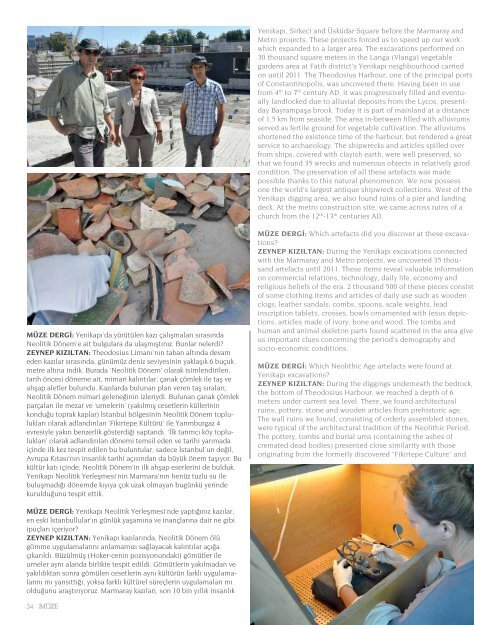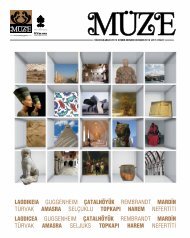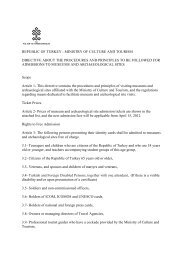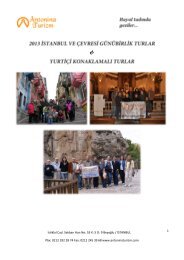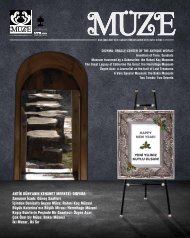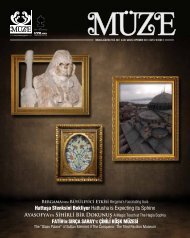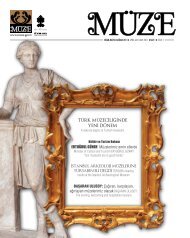GAZİANTEP ZEUGMA MOZAİK MÜZESİ
GAZİANTEP ZEUGMA MOZAİK MÜZESİ
GAZİANTEP ZEUGMA MOZAİK MÜZESİ
Create successful ePaper yourself
Turn your PDF publications into a flip-book with our unique Google optimized e-Paper software.
MÜZE DERGİ: Yenikapı’da yürütülen kazı çalışmaları sırasında<br />
Neolitik Dönem’e ait bulgulara da ulaşmıştınız. Bunlar nelerdi?<br />
ZEYNEP KIZILTAN: Theodosius Limanı’nın taban altında devam<br />
eden kazılar sırasında, günümüz deniz seviyesinin yaklaşık 6 buçuk<br />
metre altına indik. Burada ‘Neolitik Dönem’ olarak isimlendirilen,<br />
tarih öncesi döneme ait, mimari kalıntılar, çanak çömlek ile taş ve<br />
ahşap aletler bulundu. Kazılarda bulunan plan veren taş sıraları,<br />
Neolitik Dönem mimari geleneğinin izleriydi. Bulunan çanak çömlek<br />
parçaları ile mezar ve ‘urnelerin’ (yakılmış cesetlerin küllerinin<br />
konduğu toprak kaplar) İstanbul bölgesinin Neolitik Dönem toplulukları<br />
olarak adlandırılan ‘Fikirtepe Kültürü’ ile Yarımburgaz 4<br />
evresiyle yakın benzerlik gösterdiği saptandı. ‘İlk tarımcı köy toplulukları’<br />
olarak adlandırılan dönemi temsil eden ve tarihi yarımada<br />
içinde ilk kez tespit edilen bu buluntular, sadece İstanbul’un değil,<br />
Avrupa Kıtası’nın insanlık tarihi açısından da büyük önem taşıyor. Bu<br />
kültür katı içinde, Neolitik Dönem’in ilk ahşap eserlerini de bulduk.<br />
Yenikapı Neolitik Yerleşmesi’nin Marmara’nın henüz tuzlu su ile<br />
buluşmadığı dönemde kıyıya çok uzak olmayan bugünkü yerinde<br />
kurulduğunu tespit ettik.<br />
MÜZE DERGİ: Yenikapı Neolitik Yerleşmesi’nde yaptığınız kazılar,<br />
en eski İstanbullular’ın günlük yaşamına ve inançlarına dair ne gibi<br />
ipuçları içeriyor?<br />
ZEYNEP KIZILTAN: Yenikapı kazılarında, Neolitik Dönem ölü<br />
gömme uygulamalarını anlamamızı sağlayacak kalıntılar açığa<br />
çıkarıldı. Büzülmüş (Hoker-cenin pozisyonundaki) gömütler ile<br />
urneler aynı alanda birlikte tespit edildi. Gömütlerin yakılmadan ve<br />
yakıldıktan sonra gömülen cesetlerin aynı kültürün farklı uygulamalarını<br />
mı yansıttığı, yoksa farklı kültürel süreçlerin uygulamaları mı<br />
olduğunu araştırıyoruz. Marmaray kazıları, son 10 bin yıllık insanlık<br />
34<br />
Yenikapı, Sirkeci and Üsküdar Square before the Marmaray and<br />
Metro projects. These projects forced us to speed up our work<br />
which expanded to a larger area. The excavations performed on<br />
30 thousand square meters in the Langa (Vlanga) vegetable<br />
gardens area at Fatih district’s Yenikapı neighbourhood carried<br />
on until 2011. The Theodosius Harbour, one of the principal ports<br />
of Constantinopolis, was uncovered there. Having been in use<br />
from 4 th to 7 th century AD, it was progressively filled and eventually<br />
landlocked due to alluvial deposits from the Lycos, presentday<br />
Bayrampaşa brook. Today it is part of mainland at a distance<br />
of 1,5 km from seaside. The area in-between filled with alluviums<br />
served as fertile ground for vegetable cultivation. The alluviums<br />
shortened the existence time of the harbour, but rendered a great<br />
service to archaeology. The shipwrecks and articles spilled over<br />
from ships, covered with clayish earth, were well preserved, so<br />
that we found 35 wrecks and numerous objects in relatively good<br />
condition. The preservation of all these artefacts was made<br />
possible thanks to this natural phenomenon. We now possess<br />
one the world’s largest antique shipwreck collections. West of the<br />
Yenikapı digging area, we also found ruins of a pier and landing<br />
deck. At the metro construction site, we came across ruins of a<br />
church from the 12 th -13 th centuries AD.<br />
MÜZE DERGİ: Which artefacts did you discover at these excavations?<br />
ZEYNEP KIZILTAN: During the Yenikapı excavations connected<br />
with the Marmaray and Metro projects, we uncovered 35 thousand<br />
artefacts until 2011. These items reveal valuable information<br />
on commercial relations, technology, daily life, economy and<br />
religious beliefs of the era. 2 thousand 500 of these pieces consist<br />
of some clothing items and articles of daily use such as wooden<br />
clogs, leather sandals, combs, spoons, scale weights, lead<br />
inscription tablets, crosses, bowls ornamented with Jesus depictions,<br />
articles made of ivory, bone and wood. The tombs and<br />
human and animal skeleton parts found scattered in the area give<br />
us important clues concerning the period’s demography and<br />
socio-economic conditions.<br />
MÜZE DERGİ: Which Neolithic Age artefacts were found at<br />
Yenikapı excavations?<br />
ZEYNEP KIZILTAN: During the diggings underneath the bedrock,<br />
the bottom of Theodosius Harbour, we reached a depth of 6<br />
meters under current sea level. There, we found architectural<br />
ruins, pottery, stone and wooden articles from prehistoric age.<br />
The wall ruins we found, consisting of orderly assembled stones,<br />
were typical of the architectural tradition of the Neolithic Period.<br />
The pottery, tombs and burial urns (containing the ashes of<br />
cremated dead bodies) presented close similarity with those<br />
originating from the formerly discovered “Fikirtepe Culture” and


